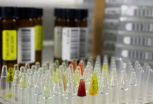(Press-News.org) UCLA stem cell scientists have shown that two common tumor suppressor genes, TSC and PTEN, are vital to regulating the stem cell-like precursor cells that create the blood supply in Drosophila, the common fruit fly.
The researchers examined a signaling pathway called TOR that the cells use to gauge nutrition levels and stress, said study senior author Dr. Julian A. Martinez-Agosto, an assistant professor of human genetics and pediatrics and a researcher with the Eli and Edythe Broad Center of Regenerative Medicine and Stem Cell Research at UCLA.
"We wondered how an organism knows how many blood cells to make and when to make them in the context of injury and repair to tissue. In particular, we wondered how the blood progenitor cells sense that change and know when it's time to make more blood cells," Martinez-Agosto said. "We found that the TOR pathway uses these two genes to regulate its function and, when activated, it expands or increases the number of blood progenitor cells in the fly's blood."
The study appears Sept. 5, 2012 in the advance online issue of the peer-reviewed journal Development.
Michelle Dragojlovic-Munther, a graduate student in the Martinez-Agosto laboratory and first author of the study, found that cells with increased activity of TOR have a competitive advantage, allowing them to divide and make more of themselves so they can make blood. These progenitors, Dragojlovic-Munther found, also have high levels of reactive oxygen species (ROS) - ions or very small molecules that include free radicals – which are known to damage cells and can predispose humans to aging and heart disease. But in this case, the ROS proved valuable.
The precursors, Martinez-Agosto said, were producing ROS all the time and when TOR was activated, the levels increased dramatically. Too much ROS caused them to divide more than normal. If they treated the flies with antioxidants, which reduce ROS levels, the cells would develop normally.
The finding could be important because the TOR pathway is abnormally activated in many cancers, and it may be possible to target the levels of ROS, which may help regulate the pathway.
"What this study may be telling us is that too much ROS is causing more cells to divide and we may be able to target therapies that reduce ROS to significantly improve the condition," Martinez-Agosto said, adding that specifically targeted antioxidants might be a potential treatment in certain subsets of blood disorders. "Sometimes that pathway is working more than it should, and we need the right amount of ROS for balance. It's like Goldilocks, there can't be too little or too much. We need it just right."
Going forward, Martinez-Agosto and his team will try to determine where the ROS is coming from and perhaps discover an enzyme that may be a good target for therapeutics. They know that the higher ROS levels in blood progenitors are not coming from mitochondria, the cell's power source, but have not identified how they are being produced.
"This study highlights mechanistic differences between TSC and PTEN on TOR function and demonstrates the multifaceted roles of a nutrient-sensing pathway in orchestrating proliferation and differentiation of myeloid-specific blood progenitors through regulation of ROS levels and the resulting myeloproliferative disorder when deregulated," the study states.
###The study was funded by a Ruth L. Kirschstein National Research Service Award from the National Institutes of Health (GM007185) and the David Geffen School of Medicine at UCLA.
The stem cell center was launched in 2005 with a UCLA commitment of $20 million over five years. A $20 million gift from the Eli and Edythe Broad Foundation in 2007 resulted in the renaming of the center. With more than 200 members, the Eli and Edythe Broad Center of Regenerative Medicine and Stem Cell Research is committed to a multi-disciplinary, integrated collaboration of scientific, academic and medical disciplines for the purpose of understanding adult and human embryonic stem cells. The center supports innovation, excellence and the highest ethical standards focused on stem cell research with the intent of facilitating basic scientific inquiry directed towards future clinical applications to treat disease. The center is a collaboration of the David Geffen School of Medicine, UCLA's Jonsson Cancer Center, the Henry Samueli School of Engineering and Applied Science and the UCLA College of Letters and Science. To learn more about the center, visit our web site at http://www.stemcell.ucla.edu.
Tumor suppressor genes vital to regulating blood precursor cells in fruit flies
2012-09-05
ELSE PRESS RELEASES FROM THIS DATE:
Ecosystems cope with stress more effectively the greater the biodiversity
2012-09-05
Higher average temperatures and increasing salt concentrations are stress factors that many ecosystems face today in the wake of climate change. However, do all ecosystems react to stress in the same way and what impact does stress have on ecosystem services, such as biomass production? Botanists and ecologists from the universities of Zurich and Göttingen demonstrate that a high level of biodiversity aids stress resistance.
Higher number of species leads to greater stress resistance
The scientists studied a total of 64 species of single-celled microalgae from the SAG ...
Kessler Foundation releases preliminary research findings for Ekso in spinal cord injury
2012-09-05
West Orange, NJ. September 5, 2012. Kessler Foundation has released preliminary research findings from its clinical study of the wearable robotic exoskeletal device, Ekso (Ekso Bionics). Gail Forrest, PhD, assistant director of Human Performance and Engineering Research, presented the Ekso research data on September 3, at the meeting of the Academy of Spinal Cord Injury Professionals at the Rio Suites in Las Vegas. Dr. Forrest directs mobility research at the Foundation, including activity-based locomotor therapy, functional electrical stimulation, and treadmill training ...
Possible new therapy for the treatment of a common blood cancer
2012-09-05
Research from Karolinska Institutet in Sweden shows that sorafenib, a drug used for advanced cancer of the kidneys and liver, could also be effective against multiple myeloma. The disease is one of the more common forms of blood cancer and is generally incurable.
"Recently developed drugs, like bortezomib, have increased the survival rate for people with this serious and complex disease," says study leader Theocharis Panaretakis, docent of experimental oncology. "Having said this, the heterogeneity of the disease progression, the treatment response and the development ...
Brainy beverage: Study reveals how green tea boosts brain cell production to aid memory
2012-09-05
It has long been believed that drinking green tea is good for the memory. Now researchers have discovered how the chemical properties of China's favorite drink affect the generation of brain cells, providing benefits for memory and spatial learning. The research is published in Molecular Nutrition & Food Research.
"Green tea is a popular beverage across the world," said Professor Yun Bai from the Third Military Medical University, Chongqing, China. "There has been plenty of scientific attention on its use in helping prevent cardiovascular diseases, but now there is emerging ...
Can videogaming benefit young people with autism spectrum disorder?
2012-09-05
New Rochelle, NY, September 5, 2012—According to the Centers for Disease Control and Prevention (CDC), 1 in 88 children in the U.S. has autism spectrum disorder (ASD), a broad group of neurodevelopmental disorders. Children and adolescents with ASD are typically fascinated by screen-based technology such as videogames and these can be used for educational and treatment purposes as described in an insightful Roundtable Discussion published in Games for Health Journal: Research Development, and Clinical Applications, a peer-reviewed publication from Mary Ann Liebert, Inc.. ...
Trout will become extinct in the Iberian Peninsula in less than 100 years
2012-09-05
Climate change, pollution, the extraction of water for irrigation and overfishing all threaten the survival of the common trout. This fish is very sensitive to changes in its environment and, according to the Spanish study, its habitat will have reduced by half by the year 2040 and will have completely disappeared from Iberian rivers by 2100, so its population will become extinct.
Global warming is threatening the existence of many fish species, especially those in the salmonid family, which are sensitive to temperature changes as they require clear and fresh water to ...
Infections in rheumatoid arthritis patients: Mayo Clinic study finds way to pinpoint risk
2012-09-05
ROCHESTER, Minn. -- Rheumatoid arthritis alone is painful and disabling, but it also puts patients at higher risk of death. The greater susceptibility to infections that accompanies the autoimmune disorder is one reason. Assessing the danger of infection a particular patient faces so it can be addressed can prove challenging for physicians. A Mayo Clinic study finds that a risk score can be developed to predict a patient's chances of having serious infections. The score uses information about how rheumatoid arthritis is affecting a patient, plus factors including age, corticosteroid ...
Epigenetic causes of prostate cancer
2012-09-05
This press release is available in German.
In about half of all prostate tumours, there are two genetic areas that are fused with one another. When this is not the case, the exact way cancer cells originate in prostate tumours was not clear until now. Scientists at the Max Planck Institute for Molecular Genetics in Berlin, in cooperation with a team of international researchers, were able to show that the genesis of this fusion-negative prostate cancer has epigenetic causes: methyl groups are distributed differently over the DNA in the cancer cells than in healthy cells. ...
Harnessing anticancer drugs for the future fight against influenza
2012-09-05
Medical Systems Virology group at the Institute for Molecular Medicine Finland (FIMM) at the University of Helsinki, together with its national and international collaborators, developed a new cell screening method that can be used to identify potential anti-influenza drugs. The researchers were able to identify two novel compounds with anti-influenza activity, obatoclax and gemcitabine and prove the efficacy of a previously known drug saliphenylhalamide.
The study was recently accepted for publication in the Journal of Biological Chemistry and is now available online.
Influenza ...
DNA sequences need quality time too - guidelines for quality control published
2012-09-05
Like all sources of information, DNA sequences come in various degrees of quality and reliability. To identify, proof, and discard compromised molecular data has thus become a critical component of the scientific endeavor - one that everyone generating sequence data is assumed to carry out before using the sequences for research purposes.
"Many researchers find sequence quality control difficult, though", says Dr. Henrik Nilsson of the University of Gothenburg and the lead author of a new article on sequence reliability, published in the Open Access journal MycoKeys. ...



